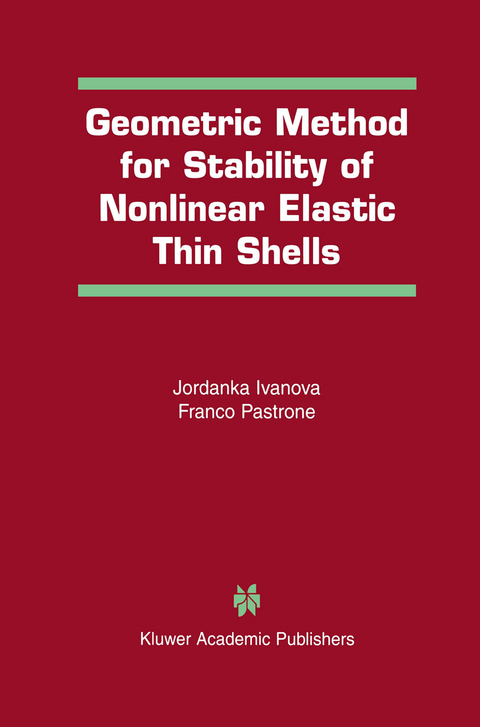
Geometric Method for Stability of Non-Linear Elastic Thin Shells
Springer-Verlag New York Inc.
978-1-4613-5590-8 (ISBN)
1. Postcritical Deformations of Thin Anisotropic Shells.- 1.1. Geometric Method in the Nonlinear Theory of Thin Shells.- 1.2. Asymptotic Form of the Poscritical Deformation Energy of Elastic Anisotropic Shells.- 1.3. Postcritical Deformations of Shallow Strongly Convex Orthotropic Shells.- 1.4. Cylindrical Orthotropic Shells under Axial Compression.- 1.5. Mechanical Interpretation of the Berger’s Hypothesis for the Global Stability of Statically Loaded Anisotropic Shells.- 2. Postcritical Deformations of Thin Elastic Anisotropic Shells with Linear Memory.- 2.1. Introduction.- 2.2. Variational Principle A for Thin Elastic Anisotropic Shells with Linear Memory.- 2.3. Postcritical Deformations of Thin Elastic Orthotropic Cylindrical Shells with Linear Memory under Uniform External Pressure.- 2.4. Postcritical Deformations of Thin Orthotropic Cylindrical Shells with Linear Memory. Nonlinear Effect of a Kernel Parameter ?.- 3. Variational Principle for Global Stability of Elasto-Plastic Thin Shells.- 3.1 Introduction.- 3.2 Asymptotic Expression for the Energy of Postcritical Deformations of Elasto-Plastic Shells.- 3.3. Postcritical Behavior of Thin Cylindrical Elasto- Plastic Shells under Axial Compression.- 4. Instability of Thin Elastic and Elasto-Plastic Orthotropic Shells under Combined Static and Dynamic Loading.- 4.1 Introduction.- 4.2 Asymptotic Analysis of Nonlinear Partial Differential Dynamic Equations for Thin Elastic Anisotropic Shells.- 4.3 Cylindrical Orthotropic Shells under Combined Axial Compression Loading.- 4.4. Cylindrical Orthotropic Shells under Combined Uniform External Pressure Loading.- 4.5. Cylindrical Orthotropic Shells under Static Axial Compression and Short-Duration.- Dynamic Impulse of External Pressure.- 4.6. Strictly Convex OrthotropicShells under Combined Dynamic Loading. Expression for the Postcritical Deformation Energy.- 4.7. Dynamic Instability of Strictly Convex Elastic Orthotropic Shells under Combined External Pressure Loading. Critical Parameters of the Process.- 4.8. Appendix to Section 4.4.- 4.9. Dynamic Instability of Cylindrical Elasto-Plastic Shells Subjected to Combined Axial Compression Loading.- 5. Crushing of Plastic Cylindrical Shells Sensitive to the Strain Rate under Axial Impact.- 5.1. Introduction.- 5.2. Mathematical Modelling of the Crushing Process.- 5.3. Axisymmetric (Concertina) Crushing Mode.- 5.4. Theoretical Method.- 5.5. Characteristics Independent of the Crushing Mode.- 5.6. Comparison between Theoretical and Experimental Data.- 6. Appendices.- 6.1. Introduction.- 6.2. Special Isometric Transformations of Cylindrical Surfaces.- 6.3. Some Information from the Theory of Surfaces.- References.
| Zusatzinfo | 1 Illustrations, black and white; XIII, 244 p. 1 illus. |
|---|---|
| Verlagsort | New York, NY |
| Sprache | englisch |
| Maße | 155 x 235 mm |
| Themenwelt | Mathematik / Informatik ► Mathematik ► Angewandte Mathematik |
| Naturwissenschaften ► Physik / Astronomie ► Mechanik | |
| Technik ► Maschinenbau | |
| ISBN-10 | 1-4613-5590-7 / 1461355907 |
| ISBN-13 | 978-1-4613-5590-8 / 9781461355908 |
| Zustand | Neuware |
| Informationen gemäß Produktsicherheitsverordnung (GPSR) | |
| Haben Sie eine Frage zum Produkt? |
aus dem Bereich


